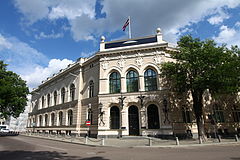Latvijas Banka
| Headquarters |
Riga , Latvia |
| founding | September 7, 1922 |
| president | Ilmārs Rimšēvičs |
| country | Latvia |
| currency | |
| ISO 4217 | EUR |
| Website | |
| predecessor |
soviet state bank ( Gosbank ) |
| List of central banks | |
Latvijas Banka ( Latvian 'Latvian Bank') is the central bank of the Republic of Latvia . It is a member of the Eurosystem , the European System of Central Banks and the General Council of the European Central Bank . In this way, the bank also has an influence on the monetary and economic policy of the EU .
history
The Republic of Latvia declared itself independent on November 18, 1918. One of the first tasks of the state was to determine the foundations of the financial system and the currency of the country. On September 7, 1922, the constituent assembly passed a provisional law on the central bank, which gave Latvijas Banka, among other things, the right to issue the national currency. In the same year, the Latvian lats was introduced. It replaced the Latvian ruble, 50 rubles corresponded to one lats. The final law on the central bank was passed by the Saeima on April 24, 1923 and signed by President Jānis Čakste on July 2 of the same year .
During the period of the first Soviet occupation of Latvia from June 17, 1940, the country's private banks were nationalized under the umbrella of Latvijas Banka , before it was dissolved on October 10, 1940. Its functions were taken over by a republic office of the Soviet central bank Gosudarstvenny bank SSSR . During the interim German occupation of Latvia from 1941 to 1945, Latvijas Banka was able to resume operations to a limited extent; she was denied the right to issue a currency.
With the regaining of independence, the Central Bank of the Republic of Latvia was restored and the lats reintroduced. On January 1, 2014, this was replaced by the euro as the national currency.
In addition to its headquarters in Riga , the bank has three branches in Daugavpils , Rēzekne and Liepāja .
tasks
During the recovery of Latvian independence, the functions of the central bank were confirmed in two laws. “Par bankām” and “Par Latvijas Banku” were adopted before the collapse of the Soviet Union , but were not finally adopted until 1992. The laws define Latvijas Banka as an independent, autonomous central bank, with the exclusive right to issue the national currency. Further tasks are the control of the national banking sector and payment transactions, the control of the national monetary policy and the administration of the state treasury. According to the Par Latvijas Banku law, one of the bank's primary goals is to keep inflation under control. In addition, the central bank influences the macro-economic conditions and contributes to sustainable economic growth that is stable over time.
management
Latvijas Banka is run by a board of directors composed of a chairman, his deputy and six ordinary members. The chairman of Latvijas Banka has been Ilmārs Rimšēvičs since 2001 . His predecessor was Einars Repše 1991-2001 . On February 20, 2018, Rimšēvičs was suspended from duty on charges of corruption.
swell
- Objectives of the Bank of Latvia (English, viewed August 18, 2011)
- History of the Bank of Latvia (viewed August 18, 2011)
Web links
- Latvijas Banka website (Latvian / English)
Individual evidence
- ↑ Latvia speaks of a Russian attempt at destabilization. In: www.nzz.ch. February 21, 2018, accessed February 21, 2018 .
